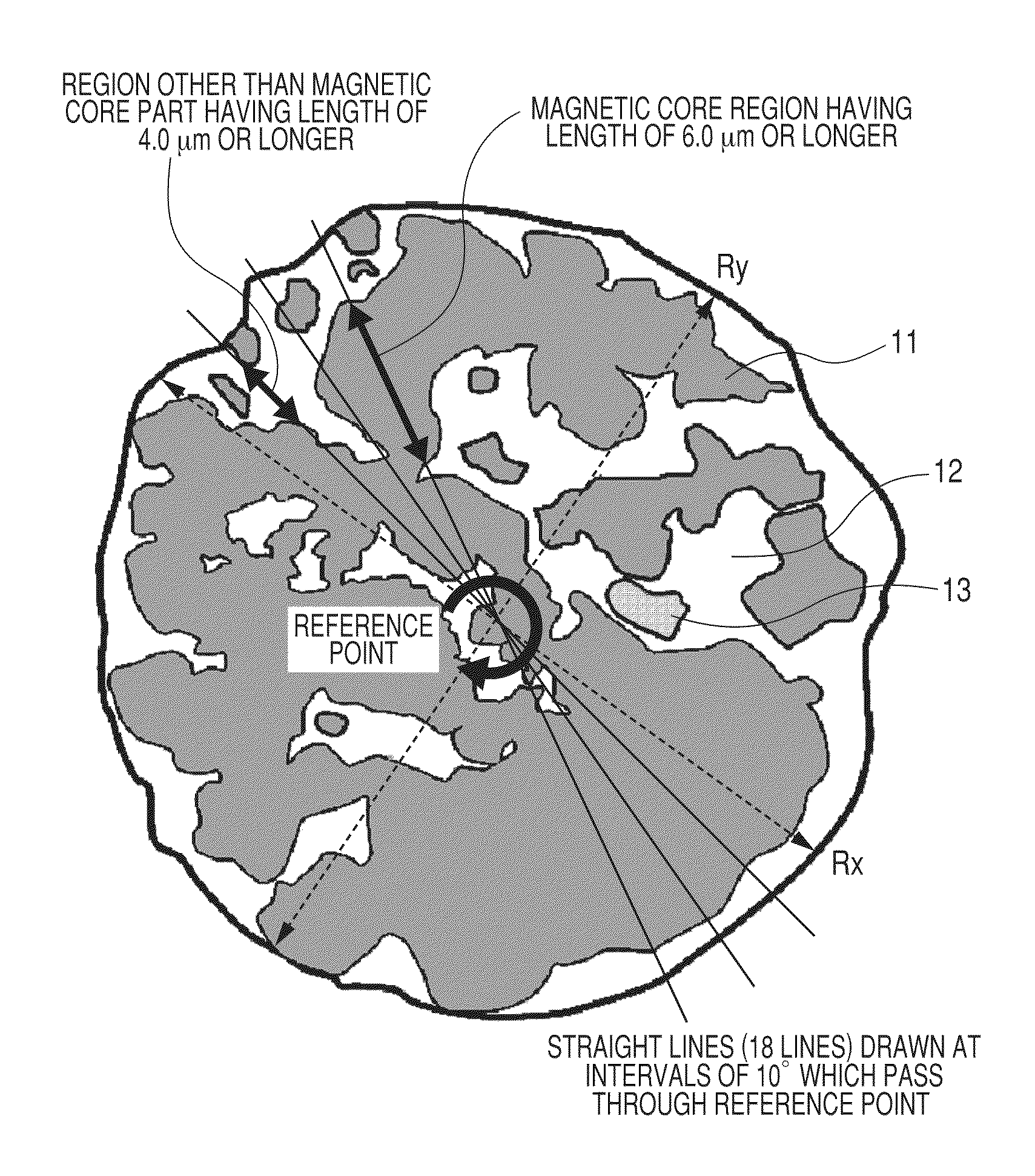Magnetic carrier and two component developer
a technology of two components and carriers, applied in the field of magnetic carriers and two component developers, can solve the problems of deterioration of developers, easy occurrence, image density variation, etc., and achieve the effect of excellent reproducibility and high quality
- Summary
- Abstract
- Description
- Claims
- Application Information
AI Technical Summary
Benefits of technology
Problems solved by technology
Method used
Image
Examples
production example 2
of the Porous Magnetic Core
[0206]In the production example 1 of the porous magnetic core, the following conditions were changed. Namely, in Step 3, the degree of crushing particles in the crusher was changed from about 0.3 mm to about 0.5 mm, the balls in the wet-type ball mill were changed from stainless steel with a 10 mm diameter (φ) to zirconia with a 10 mm diameter (φ), and the crushing time was changed from one hour to two hours. The crushing time in the wet-type bead mill was changed from one hour to two hours. In Step 5, the calcination temperature was changed from 1,100° C. to 1,050° C. and the time for raising the temperature from a room temperature to the calcination temperature was changed from 3 hours to 2 hours. The other conditions were made as same as those in the production example 1 of the porous magnetic core to obtain the porous magnetic core 2. The obtained physical properties are shown in Table 1.
production example 3
of the Porous Magnetic Core
[0207]In the production example 1 of the porous magnetic core, the following conditions were changed. Namely, in Step 3, the degree of crushing particles in the crusher was changed from about 0.3 mm to about 0.5 mm, the balls in the wet-type ball mill were changed from stainless steel with a 10 mm diameter (φ) to zirconia with a 10 mm diameter (φ), and the crushing time was changed from one hour to two hours. The crushing time in the wet-type bead mill was changed from one hour to three hours. In Step 4, 2.0 parts by mass of sodium carbonate was added as a pore controlling agent along with 2.0 parts by mass of polyvinyl alcohol as a binder to the ferrite slurry. In Step 5, the calcination temperature was changed from 1,100° C. to 1,050° C. The other conditions were made as same as those in the production example 1 of the porous magnetic core to obtain the porous magnetic core 3. The obtained physical properties are shown in Table 1.
production example 4
of the Porous Magnetic Core
[0208]In the production example 1 of the porous magnetic core, the following conditions were changed. Namely, in Step 3, the degree of crushing particles in the crusher was changed from about 0.3 mm to about 0.5 mm, the balls in the wet-type ball mill were changed from stainless steel with a 10 mm diameter (φ) to zirconia with a 10 mm diameter (φ), and the crushing time was changed from one hour to three hours. The beads in the wet-type bead mill were changed from zirconia with a 1.0 mm diameter (φ) to alumina with a 1.0 mm diameter (φ) and the crushing time was changed from one hour to two hours. In Step 4, 0.5 parts by mass of sodium carbonate was added as a pore controlling agent along with 2.0 parts by mass of polyvinyl alcohol as a binder to the ferrite slurry. In Step 5, the calcination temperature was changed from 1,100° C. to 1,050° C. and the calcination time was changed from 4 hours to 2 hours. The other conditions were made as same as those in t...
PUM
 Login to View More
Login to View More Abstract
Description
Claims
Application Information
 Login to View More
Login to View More - R&D
- Intellectual Property
- Life Sciences
- Materials
- Tech Scout
- Unparalleled Data Quality
- Higher Quality Content
- 60% Fewer Hallucinations
Browse by: Latest US Patents, China's latest patents, Technical Efficacy Thesaurus, Application Domain, Technology Topic, Popular Technical Reports.
© 2025 PatSnap. All rights reserved.Legal|Privacy policy|Modern Slavery Act Transparency Statement|Sitemap|About US| Contact US: help@patsnap.com



